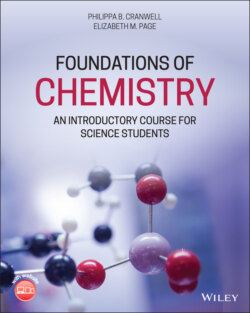Читать книгу Foundations of Chemistry - Philippa B. Cranwell - Страница 50
1.1.1 Subatomic particles
ОглавлениеUnderstanding the atom is fundamental to being able to understand, and subsequently master, chemistry. All elements are made up of atoms, and the exact structure of each atom determines which element it is. There are two main regions inside an atom: the nucleus and the outer shells surrounding the nucleus. Within the nucleus are two types of subatomic particles: protons and neutrons. The number of protons in an atom determines the actual element. The third main type of subatomic particle is found in the outer shells, and these are called electrons. Electrons are very small and are negatively charged, and they orbit the nucleus rather like planets orbit the sun. The exact manner in which an electron orbits the nucleus is defined by the orbital the electron occupies. This will be discussed in Section 1.2.4.
Protons and neutrons have the same mass and are much larger and heavier than electrons. Protons have a positive charge, and neutrons have no charge and so are neutral. Both protons and neutrons are found in the nucleus of the atom (Figure 1.1). Electrons have a much smaller mass than protons and neutrons and have a negative charge. Electrons are found in the region of space surrounding the nucleus. Table 1.1 gives the properties of the three main subatomic particles.
Figure 1.1 Simplified structure of the atom (not to scale).
Table 1.1 Properties of subatomic particles.
| Particle | Symbol | Relative mass | Charge |
|---|---|---|---|
| Proton | p | 1 | +1 |
| Neutron | n | 1 | 0 |
| Electron | e | 0.00055 | −1 |
